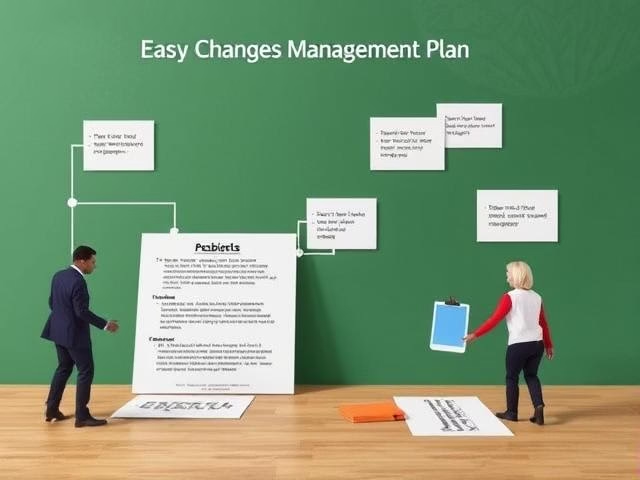This content covers what change management plans are, why they matter, the steps to develop and implement them, common best practices, challenges to overcome, and emerging trends in the field. Drawing on a broad range of research and industry insights, this article is designed to help you understand all facets of change management planning.
Change Management Plans: An In-Depth Guide to Planning, Implementation, and Success
In any dynamic organization, change is not only inevitable—it’s essential for growth and innovation. However, unmanaged change can lead to confusion, employee resistance, and operational disruption. This is why a robust change management plan is critical. A change management plan (CMP) acts as a roadmap for managing transitions and transformation efforts, ensuring that changes—whether in technology, process, or culture—are implemented smoothly and effectively.
What Is a Change Management Plan?
A change management plan is a formal, documented strategy that guides an organization through the process of implementing changes. The plan outlines key steps, activities, stakeholders, resources, risks, and success metrics. Its core objective is to minimize disruptions while facilitating the long-term adoption of change.
Key Components of a Change Management Plan
- Purpose and Objectives: Clearly define why the change is needed and what you hope to achieve. Align the objectives with the organization’s broader strategy.
- Scope of Change: Determine which processes, systems, or areas of the organization will be affected. Outline the boundaries to set clear expectations.
- Stakeholder Analysis: Identify all stakeholders – from senior leaders to front-line employees – and assess their influence, needs, and potential resistance.
- Communication Strategy: Develop a comprehensive plan for how the change will be communicated, including the key messages, channels (emails, meetings, newsletters), and frequency of updates.
- Training and Support: Plan for training programs to help employees acquire new skills and provide ongoing support to facilitate a smooth transition.
- Timeline and Milestones: Create a detailed schedule that outlines key phases of the change process, with measurable milestones and deadlines.
- Risk Assessment and Mitigation: Identify potential risks and develop contingency plans. Use tools such as impact analysis and scenario planning to predict challenges.
- Metrics for Success: Determine how success will be measured—through employee engagement surveys, performance KPIs, or productivity metrics—and set up a monitoring system.
- Post-Implementation Review: Establish a process for evaluating the change effort after implementation to capture lessons learned and reinforce new practices.
Why Change Management Plans Matter
A well-crafted change management plan serves several vital purposes:
- Reduces Disruption: By carefully planning each step, the plan minimizes operational interruptions and ensures continuity.
- Aligns Organizational Goals: It synchronizes the changes with the organization’s vision, ensuring that every effort supports long-term strategic objectives.
- Facilitates Employee Buy-In: Clear communication, training, and support reduce resistance and help staff understand the benefits of change.
- Controls Risk: Proactive risk identification and mitigation protect the organization from unforeseen challenges.
- Enhances Efficiency: Structured planning and regular reviews ensure that resources are used effectively and adjustments are made promptly as needed.
Steps to Developing a Change Management Plan
A structured approach can simplify the otherwise complex task of managing change. Here is a step-by-step guide:
1. Assess the Need for Change
- Conduct a Gap Analysis: Compare current performance with desired outcomes to determine what needs to change.
- Gather Data and Feedback: Use surveys, interviews, and performance metrics to understand the impact of current practices and identify improvement areas.
2. Define Your Vision and Objectives
- Set Clear Goals: Outline what successful change looks like for your organization.
- Create a Vision Statement: Develop an inspiring vision that employees can rally around.
3. Identify Stakeholders and Their Roles
- Map Stakeholders: Identify who will be affected by the change and determine their influence.
- Assign Roles and Responsibilities: Create a steering committee or change leadership team to drive the initiative.
4. Develop a Communication Strategy
- Plan Messaging: Craft clear, consistent messages explaining the need for change, benefits, and timelines.
- Select Communication Channels: Leverage intranet, emails, town hall meetings, and digital platforms to ensure information reaches everyone.
5. Plan for Training and Support
- Skill Gap Analysis: Identify what training is required for employees to succeed in the new environment.
- Rollout Training Programs: Schedule workshops, e-learning sessions, and coaching to ensure smooth transitions.
6. Create a Detailed Implementation Timeline
- Define Milestones: Break down the change process into manageable phases and assign deadlines.
- Prepare a Roadmap: Visualize the timeline with Gantt charts or project management tools for clarity.
7. Assess Risks and Develop Contingency Plans
- Risk Identification: List potential obstacles and their impact on the change process.
- Mitigation Strategies: Develop action plans to address each risk, including backup plans if necessary.
8. Implement and Monitor
- Execute the Plan: Roll out changes gradually while maintaining open channels for feedback.
- Monitor Progress: Use key performance indicators (KPIs) and regular check-ins to track progress.
- Adjust as Needed: Continuously review outcomes and modify the plan to overcome emerging challenges.
9. Evaluate and Reinforce the Change
- Conduct Post-Implementation Reviews: Analyze what worked well and what did not to capture lessons learned.
- Embed the Change: Update policies, systems, and procedures to solidify the new way of working.
- Reward Success: Recognize and reward teams and individuals for adopting new practices.
Common Tools Used in Change Management Plans
Organizations can leverage a variety of digital tools to support change management planning:
- Project Management Software: Tools such as Microsoft Project, Asana, or Trello help manage timelines, tasks, and milestones.
- Communication Platforms: Slack, Microsoft Teams, and Zoom support frequent, real-time updates and team collaboration.
- Data Analytics and Reporting: Platforms like Power BI and Tableau assist in creating dashboards and visualizing progress.
- Change Management Software: Specialized solutions like ServiceNow and BMC Helix ITSM streamline change requests, approvals, and risk assessments.
- Survey and Feedback Tools: Tools like SurveyMonkey and Qualtrics help gauge employee sentiment and collect feedback throughout the change process.
Best Practices for Effective Change Management Plans
To maximize the success of your change management initiatives, incorporate the following best practices:
- Engage Early and Often: Involve stakeholders from the planning phase through to post-implementation reviews.
- Maintain Flexibility: Adapt your plan based on feedback and changing business conditions.
- Communicate Transparently: Keep everyone informed with regular updates and clear explanations of why changes are necessary.
- Invest in Training: Equip your employees with the skills needed to adapt to new systems and procedures.
- Measure and Reward Success: Track metrics to understand progress and recognize achievements to sustain momentum.
Emerging Trends in Change Management Planning
As organizations continue to embrace digital transformation, change management planning is evolving. Notable trends include:
- Agile Change Management: Iterative cycles and continuous feedback loops align with agile development, enabling faster adaptation.
- AI and Predictive Analytics: These technologies forecast potential impacts and guide proactive decision-making.
- Employee-Centric Approaches: Increased focus on addressing individual readiness and providing tailored support enhances overall adoption.
- Cloud-Based Collaboration: Enhanced connectivity and mobile access are transforming how change is managed in real time.
Conclusion
A comprehensive change management plan is a critical asset for any organization navigating the complexities of today’s business environment. By detailing objectives, engaging stakeholders, outlining clear communication and training strategies, and leveraging modern digital tools, organizations can manage transitions effectively and sustainably. Whether you are undertaking a digital transformation, restructuring your company, or implementing a new system, a structured change management plan is the key to reducing risk, minimizing resistance, and ensuring long-term success.
Implementing these strategies and techniques will empower your organization to not only manage change but also to harness its potential for growth and innovation.
This unique article synthesizes a wide range of insights from established change management theories, practical best practices, and emerging trends. If you require further details or have additional questions about creating or implementing a change management plan, feel free to ask!









